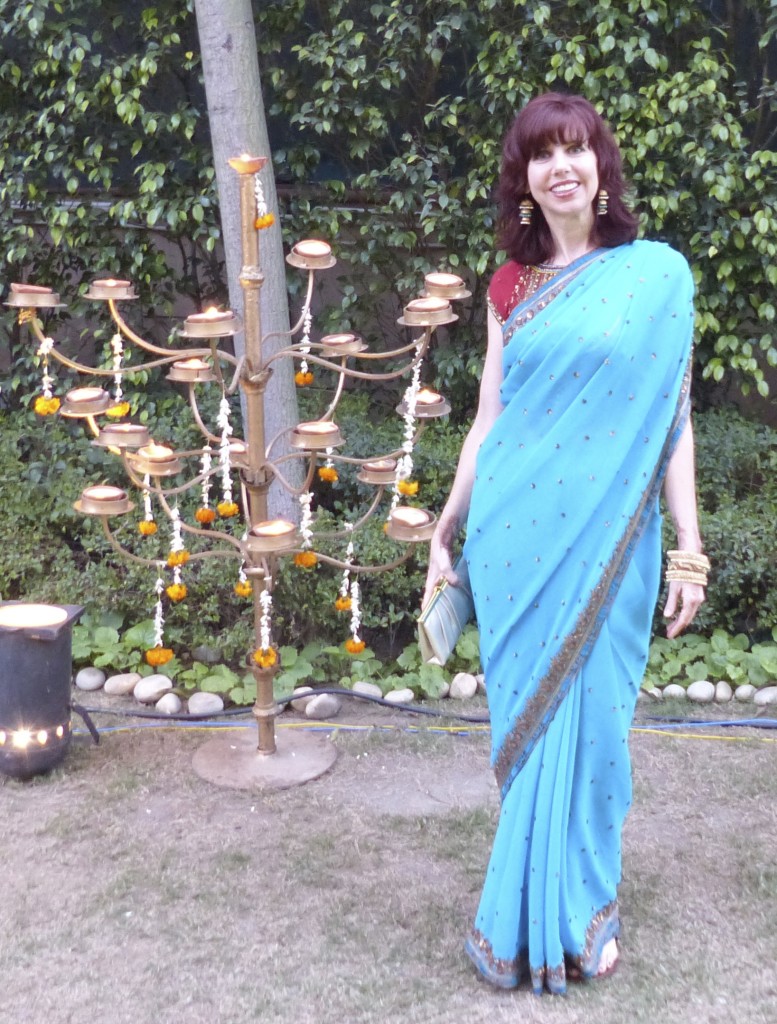In my closet here in New Delhi, I have a stunning lehenga with a long full skirt of gold and a low-back fitted top heavy with beads. The sheer saffron dupatta adds an extra touch of glamour. When elegant occasions (or fabulous photo opps with friends) arise, it’s my go-to garment. Other ladies opt for the sari, but my one experience draped in six yards of slippery chiffon filled me with anxiety. Sure, several large safety pins held it securely in place, but I spent the evening worried I or someone else would step on the hem and bring the whole mess down around my ankles.
The thing is, my lehenga is almost too fabulous. It’s actually a tad over the top. I feel a tiny competitive urge to understand the sari and its appeal to Indian ladies. Women from all walks of life wear it effortlessly – riding sidesaddle on the back of a motorcycle, swishing through a crowded cocktail party, balancing a basket of bricks atop their heads at a construction site, strolling arm-in-arm with friends, shopping, dancing, driving. I’ve seen young girls playing volleyball in their saris. What’s to fear?
A group of us from AES spent my birthday afternoon learning more about India’s sari tradition and experimenting with several styles. Textile scholar Rta Kapur Chishti has published several books about saris, including Saris of India: Tradition and Beyond, and her label TAANBAAN promotes the revival of hand spinning and hand weaving in India. She launched The Sari School in 2009 to promote and celebrate “the unstitched garment.”
“We have great backsides in India,” Chishti said. “We have great backsides and great busts. But we don’t reveal them. We drape them.”
With that, she kicked off her fascinating – and cheeky – presentation. Her slides took us on a tour with photos and facts about saris in most of the Indian states. The white saris of Kerala were traditionally splashed with turmeric or vermillion for a wedding, but the new bride would wash it clean again for daily use. Many Chinese artisans settled in Gujarat, explaining the heavily embroidered saris there. Madya Pradesh is known for its 9-yard sari and double-color borders. Ladies in Andara pleat their saris in the back. And so on. She explained the science behind the sari; for example, the fabric is woven more loosely in the middle and with tighter density along the borders and free ends to better stand up to wear and tear.
The choli, a short, tight blouse, is believed to be a relatively recent addition to the sari ensemble, especially in the south. Chishti told an anecdote about a government official trying to impose western-style modesty before the arrival of a British leader. He passed out cholis to the ladies in town, who turned out for the procession with their bosoms exposed and blouses worn on their heads like colorful caps.
After the slideshow, we practiced wrapping ourselves in the provided saris. (Unfortunately, I wore jeans and a long-sleeved shirt, which looked ridiculous under the saris. Bad choice.) During a break, I was treated to a little birthday celebration with cupcakes baked by my friend Skye.
First, we learned the Mohiniattam style from Kerala, which gathers up nine yards of fabric to create a dainty look with a little apron of pleats in the front. Mine wasn’t so dainty.
Next, we learned two Bengali styles: Nadia, which seemed more stereotypical with the free end of the sari (pallu) draped over the head, and the Dhokna Jalpaiguri style, a one-shouldered drape with the pallu wrapped around back and tied in the front. Very funky!
Finally, we looped the sari through our legs for the Odissi Dance style from Orissa, which was basically a pantsuit.
Nancy and I browsed through the TAANBAAN items for sale, and I bought an eye-popping orange cotton sari. I need to get the blouse made, but then I’ll give the complicated “unstitched garmet” another shot.
Chishti’s one admonition: no pins! Yikes, I’m not sure if I’m ready for that.
You can see more photos at my flickr.com set Sari School.

